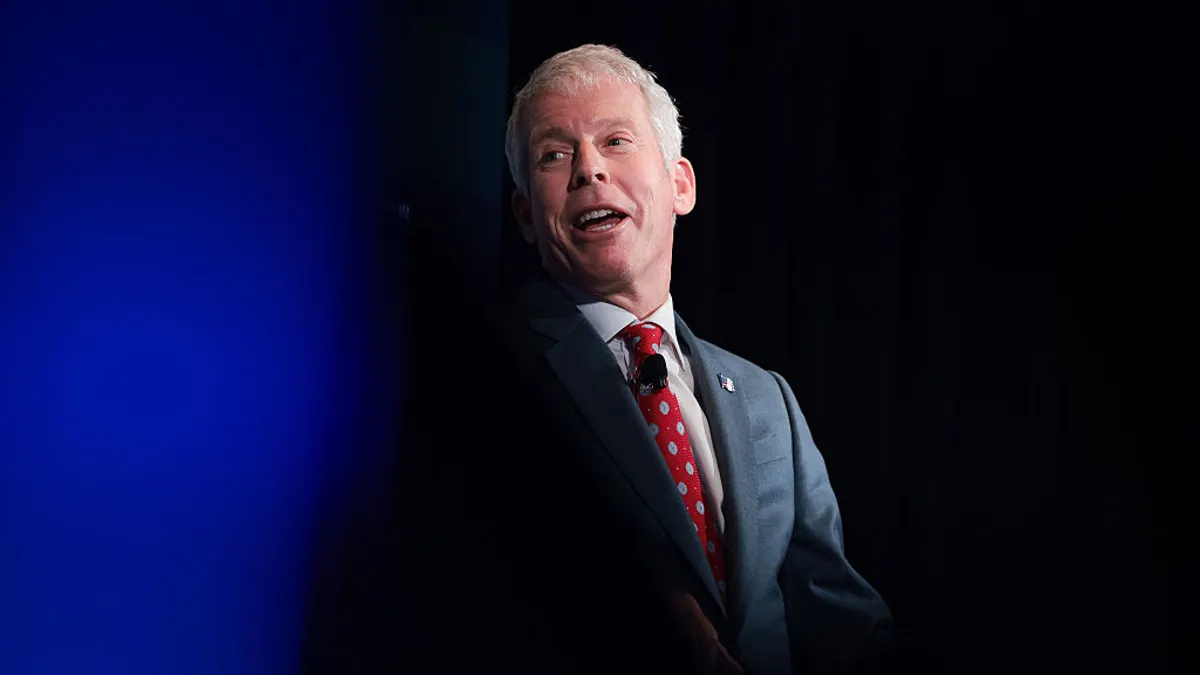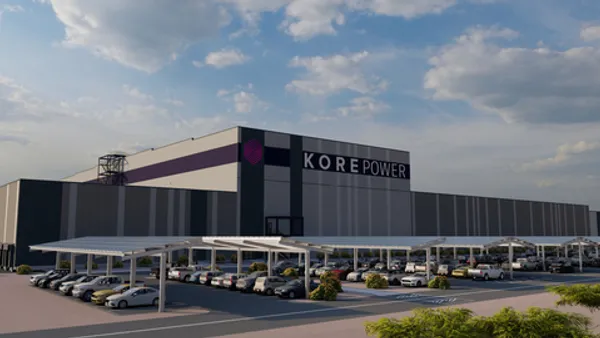President Joe Biden entered office being hailed by nuclear power advocates as perhaps the most pro-nuclear-energy president ever. He followed up his campaign trail discussions of nuclear energy as a necessary source of carbon-free emissions with a budget that proposed a record-setting $1.85 billion for the U.S. Department of Energy's Office of Nuclear Energy.
But many in the nuclear industry are concerned that the budget does not sufficiently address a problem that could prevent nuclear reactors of the future from being able to function. The impasse would stand even if technological advancements to make nuclear energy technology cheaper and easier to operate are realized. Some of the most prominent of these next-generation reactor designs can only run on a fuel for which there is no commercial supply chain currently — and building that supply chain could take years and lots of political will, according to reactor developers and nuclear fuel supply companies alike.
The nuclear industry, beset by massive cost overruns in the construction of current-generation reactors, has placed its hopes for new nuclear capacity in "advanced" or "next-generation" reactor designs, a broad category that includes everything from smaller versions of conventional light-water reactors to designs that eschew water entirely in favor of other cooling substances in the nuclear core like helium or salt. These reactors have the potential to help achieve decarbonization goals by replacing fossil fuel plants, powering the production of clean hydrogen and firming renewable energy, among other possibilities. Several companies are developing designs and targeting deployment of their first commercial demonstration projects over the next decade.
Both the Biden and Trump administrations have supported research and development efforts toward advanced reactors, and Congress has passed legislation intended to streamline the regulatory path ahead. But the Nuclear Energy Institute (NEI), the primary trade association for the nuclear industry, argues that if advanced reactors are to succeed, the federal government needs to do much more to create a domestic market for this fuel. "The commercialization of many advanced nuclear technologies is in jeopardy," NEI President and CEO Maria Korsnick said in a 2020 letter to then-U.S. Energy Secretary Dan Brouillette.
The biggest policy change advocated by NEI is for the federal government to sign a contract with a nuclear fuel supplier to essentially create a new market.
What is HALEU?
What most of the advanced reactor developers seeking Nuclear Regulatory Commission (NRC) approval have in common, however, is that they would not be fueled by the form of uranium used in most nuclear power plants operating around the world today. Rather, they would use a form that is more highly enriched — or, to be more specific, has been made into a more fissionable form by using technology such as centrifuges to alter the balance of protons and neutrons in the uranium.
Creating a steady supply of this fuel, known as high-assay low-enriched uranium, or "HALEU," however, takes time to develop. Since emissions reduction goals by states, corporations and utility companies typically have milestones that must be achieved in the 2030 to 2050 timeframe, there is a concern among nuclear advocates that advanced reactors could miss opportunities to meet that growing demand for emissions-free energy.
Based on the development timelines set by advanced reactor developers, NEI's letter to the DOE estimated that the cumulative demand for HALEU from reactors will ramp up from just 2.8 metric tons in 2021 to over 400 metric tons by 2030. "Without a HALEU supply chain or fuel supply certainty, many advanced reactor designs and advanced fuels will simply not be commercialized," Korsnick wrote in the letter.
But HALEU is not currently produced for commercial purposes anywhere in the world outside of Russia, and building new facilities to make it can take around seven years, according to Kirk Schnoebelen, head of sales at Urenco, one among the small group of companies that operates uranium enrichment facilities in the U.S. Another nuclear fuel supplier, Centrus Energy, signed a three-year agreement with the DOE in 2019 to produce HALEU on a pilot level, and after receiving a federal license, the company says it will begin HALEU production in 2022. But that pilot will produce 600 kilograms of HALEU, or under 20% of the amount required by reactor developers in 2022 alone, according to NEI's figures.
Of the seven advanced reactor designs that are engaged in "pre-application activities" with the NRC, all but one would use HALEU. Oklo, a startup that became the first advanced reactor design to formally apply to the NRC for a license for its 1.5-MW "micro-reactor" design, also plans on using HALEU.
The one design not relying on HALEU is Terrestrial Energy's Integral Molten Salt Reactor, which uses a salt-cooled rather than water-cooled core, but would run on the same uranium that conventional reactors use.
"We saw fuel supply as a constraint," according to Terrestrial Energy CEO Simon Irish, so it was important for the startup to move forward with a design that uses fuel that is available now rather than at an undetermined later date. "There's no point in building the perfect reactor if it takes 50 years to get to market," Irish said.
Many prominent advanced reactor developers have to move forward with the hope that access to HALEU will materialize because the use of the fuel is critical to the concept and value proposition of their designs. The higher enrichment level means a reactor can get more nuclear fission, and thus more energy, out of HALEU. Essentially, "It's like a really good, high-content firewood that is really dry compared to one that is damp," Jacob DeWitte, CEO and co-founder of Oklo, explained.
In general, more neutrons cause fission out of those absorbed in the fuel when using HALEU, meaning the reactor can run more efficiently. This allows for longer lived reactors, smaller reactors, and more simplified reactors compared to current plants, which use 5%-enriched uranium. All of these benefits of HALEU are what, in concept, would allow advanced reactor designs to be economically competitive, DeWitte said.
The advantages of the fuel for reactor performance are such that, if a domestic supply of HALEU did become available, Terrestrial Energy would consider switching to HALEU, Irish said. "Over the long term we are interested (in using HALEU)," he said.
TerraPower, the Bill Gates-funded startup that is developing the Natrium sodium fast reactor with GE Hitachi Nuclear Energy, is also banking on HALEU. While, at 345-MW, the Natrium reactor is much larger than Oklo's, TerraPower's design also relies on the high uranium-235 content of HALEU to allow the reactor to run efficiently, particularly when ramping up or down to follow changes in load driven by renewable energy. TerraPower declined to comment for this story. The startup and Centrus have said they plan to work together to expand HALEU production after Centrus's DOE contract ends in 2022.
'Chicken and egg situation'
It takes the same technology to enrich uranium to the 5% level as it does to enrich it to the 10% to 20% level for HALEU, Schnoebelen. The only difference is that more centrifuges need to be added for the higher enrichment level.
The much bigger challenge, he said, is primarily regulatory in nature. As part of safeguards in place to prevent the proliferation of nuclear weapons, the International Atomic Energy Agency classifies HALEU as a Category II nuclear material because its level of enrichment places it at elevated risk of being used in weapons. A uranium enrichment facility that handles HALEU must abide by a multitude of additional security measures that do not apply to current commercial facilities. As a result, a company like Urenco cannot simply add more centrifuges to an existing facility — it must construct a separate facility to enrich uranium up to HALEU levels, Schnoebelen said.
Even so, Urenco has investigated the possibility of building a facility that could produce HALEU that would be located at the site of the company's existing uranium enrichment facility in New Mexico. The project could be built for about $400 million to $600 million and would save on costs by sharing personnel and infrastructure with the existing facility, Schnoebelen said. It would take around six or seven years from the start of the license approval process with the Nuclear Regulatory Commission to the production of the first batch of HALEU, he said.
But those steps are not going into motion before there is a clear, identifiable commercial market for HALEU. "It would be a significant business risk to invest the money to make HALEU if there weren't customers to take it in the long-term," Schnoebelen said.
Advanced reactors are in a position where they need a HALEU supply for commercialization of their technology to be possible, but there needs to be commercial market with demand for the fuel in place for the HALEU supply to get off the ground, according to nuclear engineer Matthew Corradini, a professor emeritus at the University of Wisconsin. "It's a chicken and egg situation," he said.
One solution proposed by NEI is for the federal government to create the market by offering to sign long-term purchase contracts for HALEU with uranium enrichment companies. The contracts would give the fuel suppliers the certainty that if they invested in new equipment and spent the time and money acquiring new licenses and building separate facilities, they would have the federal government as a buyer at the end of the process, according to NEI Senior Technical Advisor Everett Redmond.
Another policy that could help would be to make more spent nuclear fuel available so it can be recycled into HALEU, DeWitte suggested. One way to get more spent fuel would be to extract it from U.S. Navy reactors used in nuclear submarines, he said.
But so far, despite the pro-nuclear rhetoric in Washington, the DOE has only taken "small steps" to make a domestic HALEU market a reality, Redmond said. For its fiscal year 2022 budget, the DOE is requesting $33 million for HALEU. That amount is not nearly enough to help develop the HALEU infrastructure in the U.S. to meet the expected demand growth from advanced reactors, NEI argues.
"We recommended $200 million; $33 million is a good start, but we don't think it is enough to get a strong program," Redmond said.
The DOE recognizes that the situation for HALEU supply is urgent, a DOE spokesperson said. The agency is working to determine the steps needed to create a sustainable HALEU supply by soliciting information from stakeholders and preparing a report to submit to Congress, the spokesperson said.
Most federal and private investment into advanced nuclear has gone into determining how the reactors can run safely and efficiently. For example, the DOE has an ongoing project to build a Versatile Test Reactor, a fast neutron spectrum testing facility that is intended to determine how the additional neutron irradiation in non-light-water designs could damage instruments and components inside a reactor.
While those research efforts are still expected to take years — the Versatile Test Reactor is not expected to be complete by 2026 at the earliest — even if successful, demonstrating operational safety of new reactors does not address the fuel supply issue.
"We can talk about how great it would be to have advanced reactors, but you have to have fuel for them," DeWitte said.





















